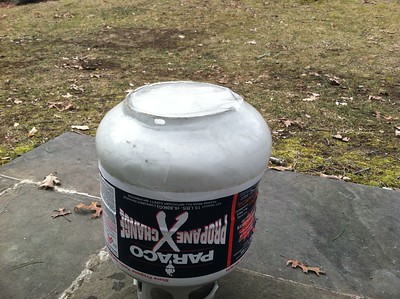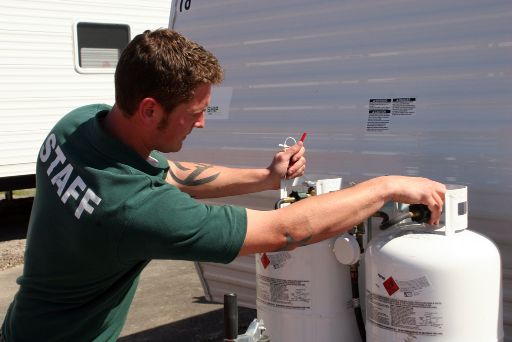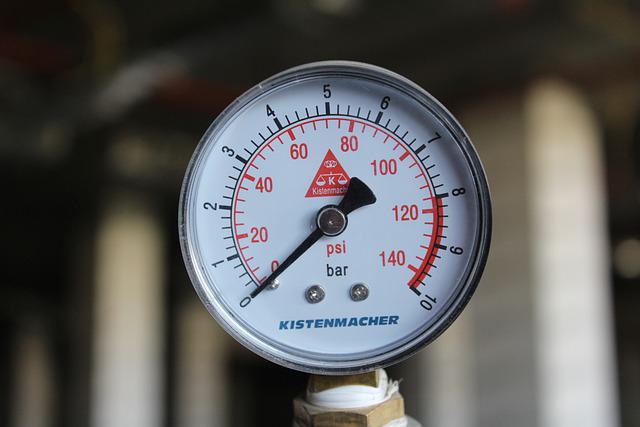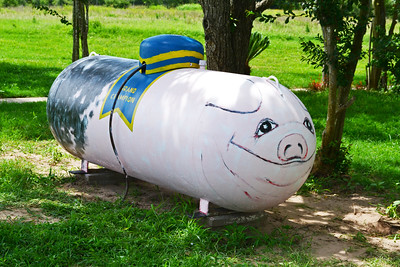
Using a propane cylinder upside down is strongly discouraged and can lead to hazardous situations. Propane cylinders are specifically designed to operate in an upright position, with the valve positioned on top. This design ensures that propane is released as a vapor, which is how propane-powered appliances are intended to function.
When a propane cylinder is used upside down, liquid propane may be released instead of vapor. This can result in a range of serious problems, including:
- Overpressure: Liquid propane entering the connected equipment, such as a grill, heater, or stove, can lead to overpressure. This can cause damage to the equipment, as it is not designed to handle liquid propane. Overpressure can also result in fires or even explosions, posing a significant risk to people and property.
- Freeze burns: Liquid propane is extremely cold, and when it comes into contact with skin, it can cause freeze burns. These injuries can be painful and potentially severe, depending on the extent and duration of exposure.
- Inefficient operation: Appliances that are designed to use propane vapor may not function properly when supplied with liquid propane. This can lead to decreased performance and increased fuel consumption.
- Malfunctioning safety features: Some propane-powered appliances have built-in safety features that rely on the proper flow of vaporized propane. When liquid propane enters the system, these safety features may not function as intended, increasing the risk of accidents.
- Regulatory and warranty issues: Using a propane cylinder upside down may violate local regulations or manufacturer warranties. This could result in fines, penalties, or voided warranties, leaving you financially responsible for any damage or injury that occurs.
To ensure the safe and proper use of propane cylinders, always follow the manufacturer’s guidelines and use them in the correct upright position.
If you are unsure about the proper handling of a propane cylinder, consult the manufacturer or a qualified professional for guidance.
By doing so, you can help prevent accidents, protect your equipment, and enjoy the benefits of propane-powered appliances with confidence.
Here’s an article about the difference between tank and cylinder.
Design and Function of Propane Cylinders
Upright position and valve orientation
Propane tanks are specifically designed to be used in an upright position, with the valve positioned on top. This design ensures that the propane is stored safely and can be easily accessed when needed. The upright position of the cylinder helps maintain the correct pressure inside the tank, allowing for the proper release of propane vapor when the valve is opened.
The valve on a propane tank is an essential component, as it controls the flow of propane from the tank to the connected appliance. The valve is designed to work in conjunction with the upright position of the cylinder, enabling the safe and efficient release of propane vapor. When a propane cylinder is placed upside down, the valve’s function can be compromised, leading to potential safety issues.
Propane vapor release versus liquid propane
When used correctly, cylinders release propane as a vapor. Propane vapor is the desired form for most propane-powered appliances, as it can be easily ignited and burns cleanly. The vapor is created by the pressure inside the cylinder, which forces the liquid propane to vaporize as it rises to the top of the tank. As the valve is opened, the vapor is released and travels through the connected hose or pipe to the appliance.
When a cylinder is used upside down, liquid propane can be released instead of vapor. This can occur because the liquid propane, which is heavier than the vapor, is now at the top of the cylinder, near the valve. Releasing liquid propane instead of vapor can lead to a variety of problems, including overpressure in the connected equipment, damage to appliances, and potential fires or explosions. Additionally, liquid propane can cause freeze burns if it comes into contact with skin. It is essential to use propane cylinders in the correct upright position to ensure the safe and proper release of propane vapor.
The need for Proper Propane Tank Usage
the need for proper propane cylinder usage is crucial for ensuring safety and the efficient operation of propane-powered appliances. Misuse or improper handling of propane cylinders can lead to a range of hazards, including fires, explosions, equipment damage, and personal injury. By following the manufacturer’s guidelines and using propane cylinders in the correct upright position, users can minimize risks and enjoy the many benefits of propane as a versatile and reliable fuel source.
Proper propane cylinder usage is essential for maintaining the performance and longevity of propane-powered appliances. Using a propane cylinder upside down can cause appliances to function inefficiently, waste fuel, and potentially lead to equipment failure. Moreover, malfunctioning safety features due to improper propane flow can increase the risk of accidents and injuries.
Adhering to proper propane cylinder usage also helps users stay in compliance with local regulations and manufacturer warranties. Ignoring guidelines or using cylinders incorrectly can result in fines, penalties, and voided warranties, leaving users financially responsible for any damage or injury that occurs.
Emphasizing the need for proper propane cylinder usage is vital to promote safety, protect equipment, and ensure the efficient operation of propane-powered appliances. By using propane cylinders in the correct upright position and adhering to the manufacturer’s guidelines, users can enjoy the convenience and reliability of propane while minimizing potential risks.
In conclusion
Using a propane cylinder upside down is strongly discouraged and can lead to dangerous consequences. Propane cylinders are specifically designed to operate in an upright position, ensuring the safe release of propane vapor to fuel appliances. When used incorrectly, liquid propane can be released, causing overpressure, equipment damage, fires, explosions, and even personal injury.
By following manufacturer guidelines and using propane cylinders in the correct upright position, users can safely enjoy the benefits of propane-powered appliances while minimizing potential hazards. It is essential to prioritize safety and proper handling to ensure the responsible and efficient use of propane cylinders.

Mike is an experienced propane technician with over 15 years of professional experience in the field. He has dedicated his career to helping customers with their propane needs, from installation to maintenance and repair. Together with Jeremy, he co-founded this website to provide useful information and guidance to customers seeking reliable propane services.




